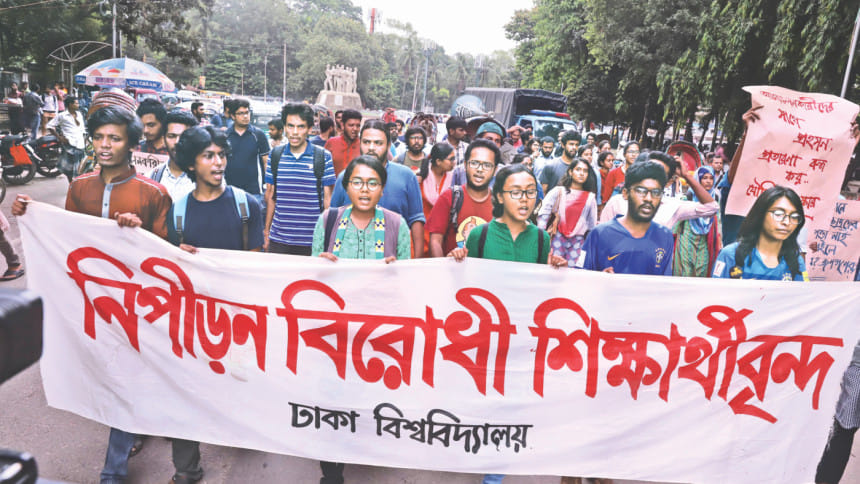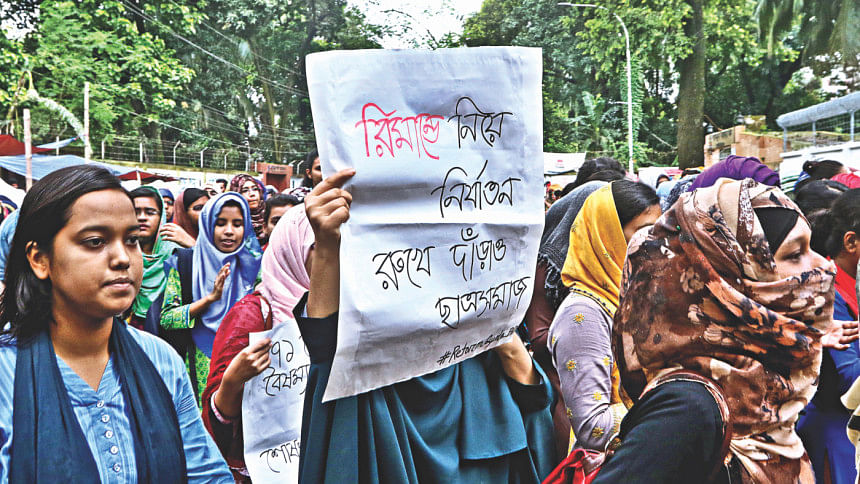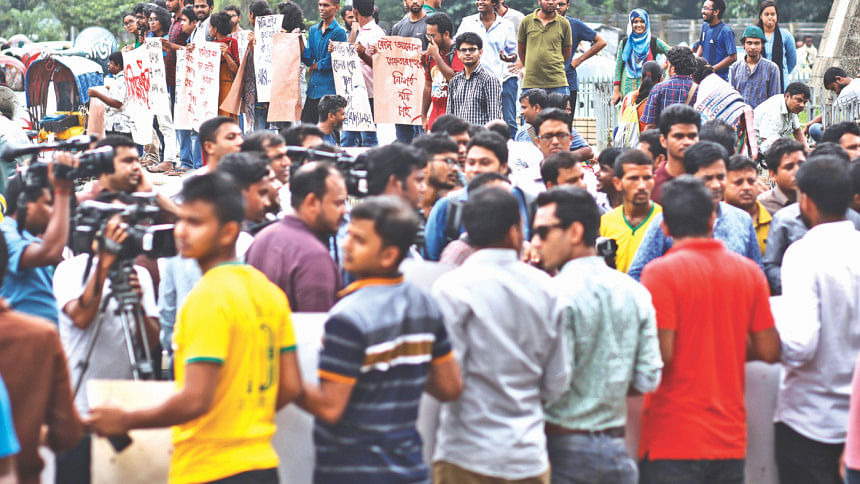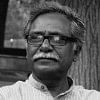Youth against fear and injustice

The public universities, old and new, are in quite a sorry state. It seems that these institutions exist only to offer support for the government's misrule. The relevant authorities are least bothered about the educational environment, research and academic leadership in their respective institutions. Rather, they are more concerned with keeping control over dormitories and university teachers.
The teachers in the administration, in most cases, depend highly on ruling party student leaders. The student residing in the residential halls are completely held hostage by these boro bhais. A rule of fear is established and the students are forced to take part in processions, zindabads, attacks and so on. They are treated like a reserve army by the leaders. The 'gono rooms' or mass rooms, a place for general students who did not get seats, are in fact torture cells, used to break the individuality of the students and render them into virtual slaves, forced into total subservience of the ruling groups.
Abrar being murdered in BUET dormitory shows the extent of the violence and domination. Abrar did not hurt anybody, he did not even make any abusive comments towards any powerful person. In his FB status, he only expressed his concern about the agreements made by the respective Prime Ministers of India and Bangladesh on water, port and others, which to me sound very logical. But the musclemen could not tolerate facts and arguments—they called him to their torture cell and beat him to death.
From Pakistan to Bangladesh: RPSO phenomenon
A careful reading of history indicates that the use of violence in student institutions, or of state-backed violence over general students, began during military rule in Pakistan. During the 1960s, a student organisation known as the National Student Federation (NSF) was formed, backed by the military regime of General Ayub Khan, to suppress the increasing mass resistance in public universities. This organisation terrorised opposition activists and did not even spare university teachers. Unfortunately, this trend did not stop even after independence; rather it intensified with every change of regime. During every regime, we find the ruling party's student wing, armed and violent, terrorising the general student population to ensure its authority. I therefore term this as the ruling party student organisation (RPSO) phenomenon.
During the Ershad regime, strong unity among student organisations played an effective role in fighting autocratic rule in the 1980s. The phase of unity among student organisations ended with the fall of the Ershad regime in 1990. Since 1991, Bangladesh has been ruled by elected governments led by either the Awami League (and alliance) or the BNP (and alliance). The ruling party's student organisation dominates educational institutions, using violent means to capture each institution. The university administration and especially the student hall administration are being controlled by the ruling party student organisation, irrespective of the ruling party.
Thus, from 1991 to 1996, Bangladesh's educational institutions were under the control of the Bangladesh Chhatra Dal, and in some places, Bangladesh Islami Chhatra Shibir. From 1997 to 2001, they were replaced by Bangladesh Chhatra League. Chhatra Dal and Shibir again came into a controlling position from 2001 until 2006.
After a gap of two years due to the military-backed interim government, Chhatra League returned to power after the Awami League won the 2008 general elections. The extent of the RPSO's domination has increased over time. With the erosion of a democratic environment, the power of RPSO leaders have increased further and the condition of educational institutions deteriorated sharply.
In recent years, newspaper reports have shown how RPSO workers are engaged as mercenaries in grabbing land and shops, snatching tender documents to ensure contracts, and harassing dissenting students. Even the university administration has used them to suppress student unrest against fee hikes, corruption, sexual harassment or other anti-student policies. In return, RPSO leaders and followers gained extra power to do whatever they wanted, including mugging, looting, sexual harassment, and forced rent collection from businesses, transport, and ordinary citizens.
Moreover, the appointment of vice chancellors has been reduced to appointing an official in the universities to support this RPSO and ensure the dominance of ruling party interests. Therefore, the nexus between corrupt 'teachers' and 'students' and their vested interests became stronger in recent years.

Recent student mobilisation
Nevertheless, in recent months, we have seen student agitation in various universities against corruption, irregularities, sexual harassment, and violence. All complaints of the agitated students have been against top officials at these institutions, including the vice chancellors and their close associates, mainly the ruling party student organisation. As a result of these protests in public universities, many vice chancellors have come under public scrutiny—two of them had to resign in Barisal and Gopalganj. The VC of Jahangirnagar University has been accused of high corruption and is facing a strong demand to resign.
It is not just in the universities. Since last year, we have seen students revolting against many issues—they have occupied streets and institutions and shaken the government's peace in autocratic rule. Last year, students looking for jobs—frustrated and deprived because of the quota system and corruption—blocked streets across the country demanding reform of the existing system. After that, much younger students shook the country again by capturing command on the streets. Thousands of school girls and boys came onto the streets after continuous killing of their fellow students by an anarchic road transport system. Teenagers in school dress occupied the streets in an angry but organised and peaceful way. They built a disciplined traffic system by controlling and challenging undisciplined VIPs, ministers, and police bosses. They stopped buses and VIP cars to check licenses of vehicles only to find that most of them were being driven by people without proper licenses and training. At one point, this teenage revolt raised slogans to repair the state. The state responded with its official and unofficial goons, creating terror and beating teenage students mercilessly. The police began to arrest not the terrorists, but the students who were exerting their public rights. In the last month, we saw thousands of school students raise their voices against climate change and to save the environment from disastrous projects.
Student power—new formation
As democratic institutions and practices are far from real in Bangladesh, a space for the healthy growth of student political and cultural activism in these institutions is still a dream and a source of continual struggle. Nevertheless, under every regime there have been sparks of protest against the RPSO violence and injustice sponsored by the state.
Many wonder how these movements could come into being despite the autocratic environment in campuses and everywhere else. It is noticeable that all these student mobilisations had a similar composition. Although left student organisations played a crucial role, these were not led by any single student organisation or their alliance. On the other hand, in every case new leadership emerged from spontaneous revolt against injustice and domination. In fact, the ruling party student wing's control of public universities has been so overwhelming that there remains little space for other student organisations to resist the misdeeds of the university authorities and the ruling party student organisation. At this stage, a new formation of student mobilisation has emerged. This formation can be traced back to the late 1990s and we see an effective role of this formation till today.
In 1998, a new alliance was formed by (mostly) female students in Jahangirnagar University to protest sexual harassment and rape on campus. Since the accused rapists and sexual harassers were ruling party leaders, no single student organisation could dare protest against them. But the participation of the female students in agitation was so powerful that their voice couldn't be silenced. The main force came from non-party general students, although leftist student organisations were consistent participants in the movement.
In the following years, similar movements appeared on other campuses to address different issues: against sexual harassment in Dhaka University (1998-9), against violence and terrorising the campus in JU (2000), and against police atrocities in one of DU's female dormitories (2002). These movements have had a significant impact on the student body politic. Other movements against rising tuition fees also occurred in the following decades by alliances of general students and leftist organisations. The mobilisations against sexual harassment had some notable results including high court directives to introduce a 'policy against sexual harassment' in every university and educational institution. Student protests against imposition of VAT on tuition fees in private universities changed the apparent non-political, passive image of these students.
Therefore, we have seen many new banners of the students around the country in the last few years to fight fear and injustice—such as 'general students' unity', 'nipironer biruddhe amra' (students against oppression), 'nipironer biruddhe jahangirnagar' (Jahangirnagar against oppression), 'durnitir biruddhe jahangirnagar' (Jahangirnagar against corruption) 'nipiron o boishomya birodhi chatrasomaj' (students against oppression and discrimination), 'beton-fee briddhi birodhi chhatra oikyo' (student alliance against fee hike), 'dhorshon protirodh moncho'(rape resistance platform), 'sundarboner jonyo amra' (students for the Sundarbans), 'jatiyo sompod rokkha torun somaj' (youth for the protection of national resources), 'quota sonskar andolon' (quota reform movement), 'nirapod sorok andolon' (road safety movement), 'no vat movement' etc.

Two strands of student politics
Therefore, we find two major strands of student politics in Bangladesh: one that perpetuates ruling class politics and social relations, and the other that challenges and strives to change them. The first strand is evident in the RPSO, which represents the ruling party, carries its mode of accumulation, and behaves like mercenaries and lobbyists of the grabbers, looters and corrupt state machine. In fact, the RPSO phenomenon indicates the degeneration of youth power.
The second strand voices for public interest—youth interest in particular, does not enjoy support from the administration (of either the state or educational institutions), and suffers hostility from the police and other people in positions of power. But this strand represents the regenerative power of the society. Although new alliances under this strand do not have any permanent organisational structure, they have a proven ability to attract significant participation from the student community and are a source of hope not only for educational institutions but also for the socio-political struggles for emancipation, democracy, equality and dignity. In the time of repression, fear, injustice—these youth rebellions give us strength to hope.
The main arguments in this essay were drawn from the author's article "Student Politics in Post-1971 Bangladesh" in Imtiaz Ahmed, Iftekhar Iqbal (ed.): University of Dhaka, Making Unmaking Remaking; Prothoma, 2016.
Anu Muhammad is Professor of Economics, Jahangirnagar University.

 For all latest news, follow The Daily Star's Google News channel.
For all latest news, follow The Daily Star's Google News channel. 



Comments